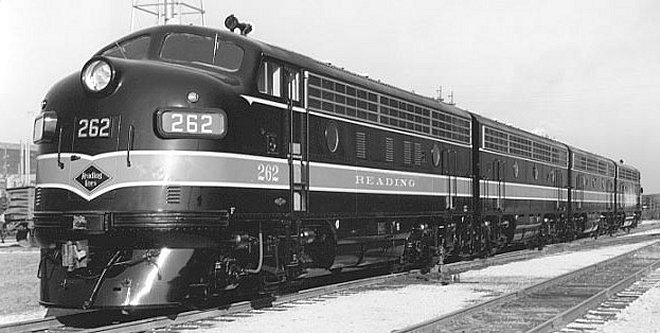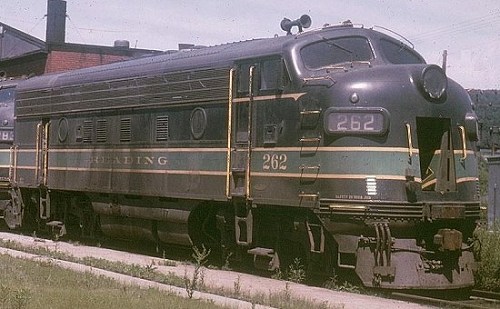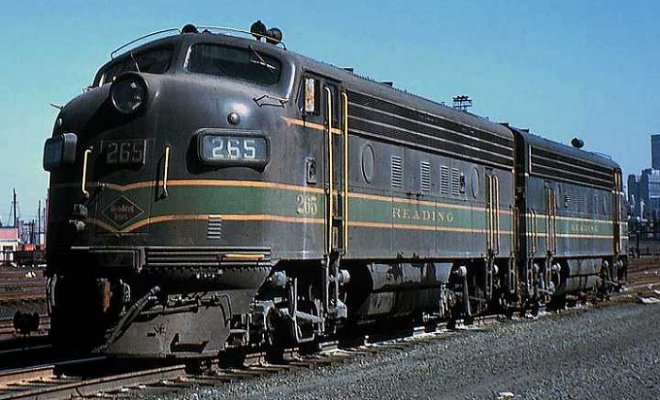EMD: F3

Following its purchase of ten EMD FT locomotives in 1945, the Reading took delivery of 6 A/B sets of EMD F3 locomotives in November, 1948. These units were classed DF-2 (for Diesel-Freight-2nd purchase) and were numbered 260 A/B through 265 A/B. The Reading's units were considered "Phase IV" units, as they were among the last to be constructed by EMD. Changes on these Phase 4 models were Farr-Air stainless steel grills replacing the "chicken wire" screening along the top of the carbody, horizontal louvers replacing screened vents and no extended vertical shrouds on the roof fans. In addition, the F3s had fewer porthole windows along the sides than the earlier FTs. Each A/B set had 3000 horsepower.
 As part of its ongoing dieselization efforts, the Reading operated the F3's in 4-unit sets for a total of 6000 horsepower. These locomotives were initially assigned to exclusive service on the Shamokin Division in order to eliminate the need for helper service on the Catawissa Branch. The delivery of the F3s, along with the concurrent arrival of the Alco FA-1s, caused a "ripple effect" that cascaded throughout the system. The Reading's FT locomotives were now assigned to Main Line service, which bumped the T-1s to New Jersey runs that had previously been handled by the Reading's big M-1 2-8-2 Mikado steam locomotives. Along with this replacement, some N-1s, remaining I-10s, and I-9s were downgraded, and 30 I-8 consolidations were retired.
As part of its ongoing dieselization efforts, the Reading operated the F3's in 4-unit sets for a total of 6000 horsepower. These locomotives were initially assigned to exclusive service on the Shamokin Division in order to eliminate the need for helper service on the Catawissa Branch. The delivery of the F3s, along with the concurrent arrival of the Alco FA-1s, caused a "ripple effect" that cascaded throughout the system. The Reading's FT locomotives were now assigned to Main Line service, which bumped the T-1s to New Jersey runs that had previously been handled by the Reading's big M-1 2-8-2 Mikado steam locomotives. Along with this replacement, some N-1s, remaining I-10s, and I-9s were downgraded, and 30 I-8 consolidations were retired.
Did You Know?
Downloads
 A variety of Reading Company operations related documents, etc. that may be of use in your modeling efforts.
A variety of Reading Company operations related documents, etc. that may be of use in your modeling efforts.
 A variety of Reading Company operations paperwork, such as train orders, clearance forms, etc. that will help you operate your Reading layout in a prototypical manner.
A variety of Reading Company operations paperwork, such as train orders, clearance forms, etc. that will help you operate your Reading layout in a prototypical manner.
 Public Timetables, Employe Timetables, and Rulebooks that provide much useful operational information.
Public Timetables, Employe Timetables, and Rulebooks that provide much useful operational information.
 Signs, billboards, and other FREE goodies for your use. We ask only that you help spread the word about The Reading Modeler!
Signs, billboards, and other FREE goodies for your use. We ask only that you help spread the word about The Reading Modeler!

